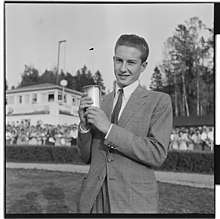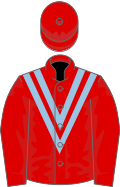Lester Piggott
Lester Keith Piggott (born 5 November 1935) is a retired English professional jockey. With 4,493 career wins, including nine Epsom Derby victories, he is widely regarded as one of the greatest flat racing jockeys of all time[2] and the originator of a much imitated style. Popularly known as "The Long Fellow" he was known for his competitive personality, keeping himself thirty pounds under his natural weight, and on occasion not sparing the whip on horses such as Roberto in the 1972 Derby. Piggott regarded Sir Ivor as the easiest to ride of the great winners.[3][4]
| Lester Piggott | |
|---|---|
 Lester Piggott in 1955 | |
| Occupation | Jockey |
| Born | 5 November 1935 Wantage, Berkshire, England |
| Spouse | Susan Armstrong (married 1951, separated) British Classic Race wins as jockey: 2000 Guineas (5) 1000 Guineas (2) Epsom Derby (9) Epsom Oaks (6) St Leger Stakes (8)[1] |
| Height | 1.73 m (5 ft 8 in) |
| Racing awards | |
| British flat racing Champion Jockey 11 times (1960, 1964, 1965, 1966, 1967, 1968, 1969, 1970, 1971, 1981, 1982) | |
| Honours | |
| OBE (withdrawn) | |
| Significant horses | |
| Never Say Die, Crepello, Petite Etoile, St. Paddy, Sir Ivor, Nijinsky, Roberto, Empery, The Minstrel, Alleged, Teenoso, Shadeed, Royal Academy, Rodrigo de Triano | |
| 1000 Guineas (2) | ||
|---|---|---|
| 1970 | ||
 |
 |
 |
| Humble Duty | Gleam | Black Satin |
| 1981 | ||
 |
 |
 |
| Fairy Footsteps | Tolmi | Go Leasing |
| 2000 Guineas (5) | ||
|---|---|---|
| 1957 | ||
 |
 |
 |
| Crepello | Quorum | Pipe of Peace |
| 1968 | ||
 |
 |
 |
| Sir Ivor | Petingo | Jimmy Reppin |
| 1970 | ||
 |
 |
 |
| Nijinsky | Yellow God | Roi Soleil |
| 1985 | ||
 |
 |
 |
| Shadeed | Bairn | Supreme Leader |
| 1992 | ||
 |
 |
 |
| Rodrigo De Triano | Lucky Lindy | Pursuit Of Love |
| Derby (9) | ||
|---|---|---|
| 1954 | ||
 |
 |
 |
| Never Say Die | Arabian Night | Darius |
| 1957 | ||
 |
 |
 |
| Crepello | Ballymoss | Pipe of Peace |
| 1960 | ||
 |
 |
 |
| St Paddy | Alcaeus | Kythnos |
| 1968 | ||
 |
 |
 |
| Sir Ivor | Connaught | Mount Athos |
| 1970 | ||
 |
 |
 |
| Nijinsky | Gyr | Stintino |
| 1972 | ||
 |
 |
 |
| Roberto | Rheingold | Pentland Firth |
| 1976 | ||
 |
 |
 |
| Empery | Relkino | Oats |
| 1977 | ||
 |
 |
 |
| The Minstrel | Hot Grove | Blushing Groom |
| 1983 | ||
 |
 |
 |
| Teenoso | Carlingford Castle | Shearwalk |
| Oaks (6) | ||
|---|---|---|
| 1957 | ||
 |
 |
 |
| Carrozza | Silken Glider | Rose Royale |
| 1959 | ||
 |
 |
 |
| Petite Etoile | Cantelo | Rose of Medina |
| 1966 | ||
 |
 |
 |
| Valoris | Berkeley Springs | Varinia |
| 1975 | ||
 |
 |
 |
| Juliette Marny | Val's Girl | Moonlight Night |
| 1981 | ||
 |
 |
 |
| Blue Wind | Madam Gay | Leap Lively |
| 1984 | ||
 |
 |
 |
| Circus Plume | Media Luna | Poquito Queen |
| St Leger (8) | ||
|---|---|---|
| 1960 | ||
 |
 |
 |
| St. Paddy | Die Hard | Vienna |
| 1961 | ||
 |
 |
 |
| Aurelius | Bounteous | Dicta Drake |
| 1967 | ||
 |
 |
 |
| Ribocco | Hopeful Venture | Ruysdael |
| 1968 | ||
 |
 |
 |
| Ribero | Canterbury | Cold Storage |
| 1970 | ||
 |
 |
 |
| Nijinsky | Meadowville | Politico |
| 1971 | ||
 |
 |
 |
| Athens Wood | Homeric | Falkland |
| 1972 | ||
 |
 |
 |
| Boucher | Our Mirage | Ginevra |
| 1984 | ||
 |
 |
 |
| Commanche Run | Baynoun | Alphabatim |
Family background and personal life
Lester Piggott was born in Wantage to a family that could trace its roots as jockeys and trainers back to the 18th century.[5] The Piggotts were a Cheshire farming family who from the 1870s ran the Crown Inn in Nantwich for over 30 years. Lester's grandfather Ernest (Ernie) Piggott (1878–1967) owned a racehorse stable at The Old Manor in Letcombe Regis and his father (Ernest) Keith Piggott (1904–1993) another at South Bank in Lambourn, where Lester lived until 1954.[5] Ernie Piggott rode three Grand National winners, in 1912, 1918 and 1919 and was married to a sister of the jockeys Mornington Cannon and Kempton Cannon, who both rode winners of the Derby, in 1899 and 1904 respectively. He was also three-times British jump racing Champion Jockey (in 1910, 1913 and 1915). Keith Piggott was a successful National Hunt jockey and trainer, winning the Champion Hurdle as a jockey in 1939 and the Grand National as a trainer in 1963 with Ayala, becoming the British jump racing Champion Trainer of the 1962–63 season. Lester Piggott is the cousin, through his mother Lilian Iris Rickaby, of two other jockeys, Bill and Fred Rickaby. Fred Rickaby was British flat racing Champion Apprentice in 1931 and 1932.
Piggott is married to Susan Armstrong. They married at St. Mark's church, North Audley Street, London in 1960. Her father, Sam Armstrong, and her brother, Robert Armstrong, were both racehorse trainers. They have two daughters, Maureen, an ex-eventer (married to Derby-winning trainer William Haggas) and Tracy (a sports presenter on Irish television station RTÉ). He also has a son, Jamie, from a relationship with Anna Ludlow.[6] He now lives in Bursinel, Switzerland with his partner and family friend Lady Barbara FitzGerald. [7] His house is named after a famous racehorse from history – Florizel.
Partial deafness and a minor speech impediment have contributed to the reputation of a taciturn nature. However his dry wit and witticisms are legion. For example, when asked by a reporter, after Karabas had won the 1969 Washington International, when did he (Lester) think he would win. Lester replied "about two weeks ago". Allegedly when asked by a brave stable employee for a £5 pound gratuity, Lester motioned the lad to talk to his 'good ear' at which the lad upped the request to £10. Lester responded with "try the other ear again". On being asked by a young girl serving him with ice-cream if he was Wilson Pickett (the black soul singer) he said "yes".[6][8]
Career as a jockey

Piggott began racing horses from his father's stable when he was 10 years old and won his first race in 1948, aged 12 years, on a horse called The Chase at Haydock Park.[9] Piggott is known for his quiet demeanour. He describes his mother as wisely playing down his success, while his father rarely gave advice unless there had been a particular mistake. By his teens a sensation in the racing world, he rode his first winner of The Derby on Never Say Die in 1954 aged 18 years and went on to win eight more, on Crepello (1957), St. Paddy (1960), Sir Ivor (1968), Nijinsky (1970), Roberto (1972), Empery (1976), The Minstrel (1977) and Teenoso (1983). He was stable jockey to Noel Murless and later to Vincent O'Brien and had a glittering career of unparalleled success. Known as the "housewives' favourite", Piggott had legions of followers and did much to expand the popularity of horse racing beyond its narrow, class-based origins.
Famously tall for a Flat jockey (5 ft 8 in/1.73 m), hence his nickname of "The Long Fellow", Piggott struggled to keep his weight down and for most of his career rode at 8 stone 6 pounds (112 lb/51 kg). He pioneered a new style of race-riding that was subsequently widely adopted by colleagues at home and abroad and enabled him to become Champion Jockey eleven times. He also rode over hurdles early in his career.
.jpg)
In 1980 his relationship with the Sangster–O'Brien combination came to an end and he was appointed as stable jockey to Noel Murless's son-in-law Henry Cecil, the British flat racing Champion Trainer, at Murless's old stables, Warren Place. He was again champion jockey in 1981 and 1982.
In late 1983 a dispute arose as to whether he had reneged on an agreement to ride Daniel Wildenstein's All Along in the Prix de l'Arc de Triomphe for Patrick Louis Biancone when Piggott stated he had agreed to ride the previous year's Arc third Awaasif and could only ride All Along if that horse did not run. All Along was ridden instead by Walter Swinburn, with Wildenstein refusing to allow Piggott to ride any more of his horses. It was costly for Piggott, as All Along won the Arc and a string of other international races in an autumn campaign that ended with her being named US Horse of the Year. Further, as Wildenstein was one of Cecil's principal owners, this placed a strain on the relationship, and in 1984 Cecil and Piggott split, with Steve Cauthen taking over at Warren Place.
In 1985 Piggott rode as a freelance with big wins including the Prix de Diane for Andre Fabre aboard Lypharita, the 2000 Guineas for Michael Stoute in Shadeed and the Benson and Hedges Gold Cup and Irish Champion Stakes for Luca Cumani on Commanche Run.
Later life
Piggott retired as a jockey at the end of the 1985 flat season and became a trainer. His Eve Lodge stables in Newmarket, Suffolk, housed 97 horses and sent out 34 winners. His burgeoning new career as a trainer was ended when he was convicted of tax fraud and jailed. He was stripped of his OBE (which he had been awarded in 1975). He served 366 days in prison. According to Piggott, a commonly held belief that he was prosecuted after using an undeclared bank account to make a final settlement of his tax liabilities is a myth.
He resumed his career as a jockey in 1990 and won the Breeders' Cup Mile on Royal Academy within ten days of his return. He rode another Classic winner, Rodrigo de Triano, in the 1992 2000 Guineas. His last win in Britain was in October 1994 and he officially retired in 1995; his last British ride was in the November Handicap on 5 November 1994, but he rode abroad through the winter of 1994/95, winning the Black Opal Stakes on Zadok in Canberra on 5 March 1995[10] before deciding not to return for the 1995 British Flat turf season.
Piggott lived near Newmarket in Suffolk for the entire duration of his career. He later emigrated to Bursinel, Switzerland where he continues to reside with his partner and family friend Lady Barbara FitzGerald.[11]
In 2004 he published the book Lester's Derbys.[12]
Illness
On 15 May 2007 Piggott was admitted to intensive care in a Swiss hospital following a recurrence of a previous heart problem. His wife stated that this illness was not life-threatening and that he was recovering in intensive care as a precaution. He attended Royal Ascot in June 2007[13] and the Epsom Derby in June 2008 where he tipped the winner, New Approach, during a BBC television interview. He was also present for Gold Cup day at the Cheltenham Festival in March 2009, where he was interviewed in the parade ring.
Recognition
The annual jockey awards The Lesters, inaugurated in 1990, are named in his honour.
In 1999, the Racing Post ranked Piggott as second in their list of the Top 50 jockeys of the 20th century, behind Gordon Richards.[14]
Major wins
- 1,000 Guineas - (2) - Humble Duty (1970), Fairy Footsteps (1981)
- 2,000 Guineas - (5) - Crepello (1957), Sir Ivor (1968), Nijinsky (1970), Shadeed (1985), Rodrigo de Triano (1992)
- Ascot Gold Cup - (11) - Zarathustra (1957), Gladness (1958), Pandofell (1961), Twilight Alley (1963), Fighting Charlie (1965), Sagaro (1975, 1976 & 1977), Le Moss (1979), Ardross (1981 & 1982)
- Champion Stakes - (5) - Petite Etoile (1959), Pieces of Eight (1966), Sir Ivor (1968), Giacometti (1974), Rodrigo de Triano (1992)
- Cheveley Park Stakes - (4) - Fleet (1966), Lalibela (1967), Durtal (1976), Marwell (1980)
- Cork and Orrery Stakes (Golden Jubilee Stakes) - (9) - Right Boy (1958 & 1959), Tin Whistle (1960), El Gallo (1963), Mountain Call (1968), Welsh Saint (1970), Saritamer (1974), Thatching (1979), College Chapel (1993)
- Coronation Cup - (9) - Zucchero (1953), Nagami (1959), Petite Etoile (1960 & 1961), Park Top (1969), Roberto (1973), Quiet Fling (1976), Sea Chimes (1980), Be My Native (1983)
- Coronation Stakes - (5) - Aiming High (1961), Calve (1972), Lisadell (1974), Roussalka (1975), Chalon (1982)
- Derby - (9) - Never Say Die (1954), Crepello (1957), St Paddy (1960), Sir Ivor (1968), Nijinsky (1970), Roberto (1972), Empery (1976), The Minstrel (1977), Teenoso (1983)
- Dewhurst Stakes - (10) - Crepello (1956), Follow Suit (1962), Ribofilio (1968), Nijinsky (1969), Crowned Prince (1971), Cellini (1973), The Minstrel (1976), Try My Best (1977), Monteverdi (1979), Diesis (1982)
- Eclipse Stakes - (7) - Mystery IX (1951), Darius (1955), Arctic Explorer (1957), St Paddy (1961), Pieces of Eight (1966), Wolver Hollow (1969), Artaius (1977)
- Falmouth Stakes - (7) - Sylphide (1957), Green Opal (1960), Chrona (1966), Vital Match (1969), Chalon (1982), Niche (1993), Lemon Souffle (1994)
- Fillies' Mile - (4) - Escorial (1973), Miss Pinkie (1976), Cherry Hinton (1977), Oh So Sharp (1984)
- Haydock Sprint Cup - (3) - Green God (1971), Abergwaun (1972), Moorestyle (1980)
- International Stakes - (5) - Dahlia (1974 & 1975), Hawaiian Sound (1978), Commanche Run (1985), Rodrigo de Triano (1992)
- July Cup - (10) - Vigo (1957), Right Boy (1958 & 1959), Tin Whistle (1960), Thatch (1973), Saritamer (1974), Solinus (1978), Thatching (1979), Moorestyle (1980), Mr Brooks (1992)
- King George VI and Queen Elizabeth Stakes - (7) - Meadow Court (1965), Aunt Edith (1966), Park Top (1969), Nijinsky (1970), Dahlia (1974), The Minstrel (1977), Teenoso (1984)
- King's Stand Stakes - (7) - Right Boy (1957), Majority Rule (1963), Swing Easy (1971), Abergwaun (1973), Godswalk (1977), Solinus (1978), Never So Bold (1985)
- Lockinge Stakes - (6) - Sovereign Path (1960), The Creditor (1964), Sparkler (1973), Belmont Bay (1981), Polar Falcon (1991), Swing Low (1993)
- Middle Park Stakes - (6) - Petingo (1967), Steel Heart (1974), Junius (1978), Mattaboy (1980), Cajun (1981), Diesis (1982)
- Nassau Stakes - (5) - Aunt Edith (1965), Haymaking (1966), Cheveley Princess (1973), Roussalka (1975 & 1976)
- Nunthorpe Stakes - (7) - Right Boy (1958 & 1959), Matatina (1963), Caterina (1966), Tower Walk (1969), Swing Easy (1971), Solinus (1978)
- Oaks - (6) - Carrozza (1957), Petite Etoile (1959), Valoris (1966), Juliette Marny (1975), Blue Wind (1981), Circus Plume (1984)
- Prince of Wales's Stakes - (3) - Gift Card (1973), Anne's Pretender (1976), Crimson Beau (1979)
- Queen Anne Stakes - (5) - Sparkler (1972), Baptism (1979), Belmont Bay (1981), Mr Fluorocarbon (1982), Trojan Fen (1984)
- Queen Elizabeth II Stakes - (4) - The Creditor (1963), Linacre (1964), Hill Rise (1966), To-Agori-Mou (1981)
- Racing Post Trophy - (5) - Ribocco (1966), Noble Decree (1972), Apalachee (1973), Dunbeath (1982), Lanfranco (1984)
- St. James's Palace Stakes - (5) - Roan Rocket (1964), Petingo (1968), Thatch (1973), Jaazeiro (1978), Bairn (1985)
- St. Leger - (8) - St Paddy (1960), Aurelius (1961), Ribocco (1967), Ribero (1968), Nijinsky (1970), Athens Wood (1971), Boucher (1972), Commanche Run (1984)
- Sun Chariot Stakes - (6) - Popkins (1970), Cheveley Princess (1973), Swiss Maid (1978), Topsy (1979), Snow (1980), Home on the Range (1981)
- Sussex Stakes - (6) - Petite Etoile (1959), Roan Rocket (1964), Petingo (1968), Thatch (1973), Artaius (1977), Jaazeiro (1978)
- Yorkshire Oaks - (4) - Petite Etoile (1959), Parthian Glance (1966), Shoot A Line (1980), Awaasif (1982)
- Canadian International Stakes - (1) - Dahlia (1974)
- Grand Critérium (Prix Jean-Luc Lagardère) - (3) - Sir Ivor (1967), Breton (1969), My Swallow (1970)
- Grand Prix de Paris - (2) - Roll of Honour (1970), Sagaro (1974)
- Grand Prix de Saint-Cloud - (1) - Teenoso (1984)
- Poule d'Essai des Pouliches - (2) - Rajput Princess (1964), River Lady (1982)
- Prix de l'Abbaye de Longchamp - (4) - Tower Walk (1969), Balidar (1970), Moorestyle (1980), Mr Brooks (1992)
- Prix de l'Arc de Triomphe - (3) - Rheingold (1973), Alleged (1977 & 1978)
- Prix de Diane - (3) - Mrs Penny (1980), Madam Gay (1981), Lypharita (1985)
- Prix de la Forêt - (2) - Moorestyle (1980 & 1981)
- Prix Ganay - (1) - Trillion (1978)
- Prix Jacques Le Marois - (1) - Nonoalco (1974)
- Prix Jean Prat - (3) - Speedy Dakota (1975), Dom Racine (1978), Night Alert (1980)
- Prix du Jockey Club - (1) - Hard to Beat (1972)
- Prix Lupin - (2) - Hard to Beat (1972), Persépolis (1982)
- Prix Marcel Boussac - (3) - Vela (1969), Play It Safe (1981), Midway Lady (1985)
- Prix Maurice de Gheest - (4) - Mountain Call (1968), Abergwaun (1972), Moorestyle (1981), College Chapel (1993)
- Prix Morny - (2) - My Swallow (1970), Nonoalco (1973)
- Prix du Moulin de Longchamp - (3) - Habitat (1969), Gold Rod (1970), Sparkler (1973)
- Prix Rothschild - (1) - Topsy (1979)
- Prix Royal-Oak - (1) - Ardross (1981)
- Prix Saint-Alary - (1) - Nobiliary (1975)
- Prix de la Salamandre - (2) - My Swallow (1970), Nonoalco (1973)
- Prix Vermeille - (1) - Aunt Edith (1965)
- Deutsches Derby - (3) - Orsini (1957), Fanfar (1963), Luciano (1967)
- Preis der Diana - (1) - On Dit (1967)
- Preis von Europa - (1) - Esprit du Nord (1983)
- Irish 1,000 Guineas - (2) - Favoletta (1971), Godetia (1979)
- Irish 2,000 Guineas - (3) - Decies (1970), Jaazeiro (1978), Rodrigo de Triano (1992)
- Irish Champion Stakes - (3) - Malacate (1976), Inkerman (1978), Commanche Run (1985)
- Irish Derby - (5) - Meadow Court (1965), Ribocco (1967), Ribero (1968), The Minstrel (1977), Shergar (1981)
- Irish Oaks - (3) - Santa Tina (1970), Juliette Marny (1975), Godetia (1979)
- Irish St. Leger - (3) - Dan Kano (1967), Caucasus (1975), Meneval (1976)
- Matron Stakes - (1) - Kalamaika (1978)
- Moyglare Stud Stakes - (1) - Lemon Souffle (1993)
- National Stakes - (4) - Cellini (1973), Sir Wimborne (1975), El Prado (1991), Fatherland (1992)
- Phoenix Stakes - (1) - Getaway (1958)
- Pretty Polly Stakes - (3) - Mariel (1971), Godetia (1979), Calandra (1980)
- Tattersalls Gold Cup - (2) - Cavo Doro (1973), Elegant Air (1985)
- Derby Italiano - (3) - Bonconte di Montefeltro (1969), Cerreto (1973), Welnor (1984)
- Gran Criterium - (1) - Alhijaz (1991)
- Gran Premio del Jockey Club - (4) - Nagami (1958), Marco Visconti (1966), Awaasif (1983), Silvernesian (1992)
- Premio Presidente della Repubblica - (1) - Moulton (1973)
- Premio Roma - (3) - Irvine (1972), Noble Saint (1979), Old Country (1985)
- Singapore Derby - (1) - Saas Fee (1979)
- Queen Elizabeth II Cup - (2) - Jumbo Jet (1972)
- Derby - (1) - Zimzalabim (1993)
- Breeders' Cup Mile - (1) - Royal Academy (1990)
- Washington, D.C. International - (3) - Sir Ivor (1968), Karabas (1969), Argument (1980)
In popular culture
The British music band James recorded a song named "Sometimes (Lester Piggott)" on their album Laid. The outro on the original 12" of Sit Down also featured a falsetto voice singing the jockey's name.
The Van Morrison song "In the Days Before Rock 'n Roll" also mentions Piggott by name: "When we let, then we bet / On Lester Piggott when we met [ten to one] / And we let the goldfish go"
Piggott was frequently caricatured on Spitting Image, in which he was portrayed as having mumbling diction which was always accompanied by subtitles.
In 1991, during a period in which Queen Elizabeth II faced public pressure to pay taxes, the satirical magazine Private Eye showed a cover picture of her talking on a telephone, asking for Lester Piggott.[15]
Lester's public house in Margate is named after Piggott.[16]
See also
References
- Morris, Tony; Randall, John (1990). Horse Racing: Records, Facts, Champions (Third ed.). Guinness Publishing. ISBN 0-85112-902-1.
- "70th Anniversary of Lester Piggott's First Ever Victory". The Jockey Club. 6 August 2018. Retrieved 4 September 2019.
- About the Home of Racing Archived 9 April 2008 at the Wayback Machine Jockey Club
- Lester Piggott to open New Wiltshire Stand at Salisbury Salisbury Racecourse Archived 24 July 2008 at the Wayback Machine
- p45, David Boyd, A Bibliographical Dictionary of Racehorse Trainers in Berkshire 1850–1939 (1998)
- Rock, Graham (6 May 2001). "Chief Whip". The Guardian. Retrieved 15 April 2019.
- https://www.theguardian.com/sport/2015/oct/13/lester-piggott-80-jockey-interview-racing
- Harris, Kenneth (7 June 1970). "A living legend". The Observer Magazine. Retrieved 15 April 2019.
- "Schoolboy rides the first winner", Daily Worker, 19 August 1948
- "Lester down under", Daily Express page 51, 6 March 1995
- "The jockey and the younger filly: Lester Piggott leaves wife for mistress 22 years his junior". 30 May 2012.
- Lester's Derbys: Lester Piggott, Sean Magee: 9780413774118: Books - Amazon.ca. amazon.ca. ASIN 0413774112.
- Lee, Alan (23 June 2007). "Piggott shows star quality in photofinish". The Timzes. Archived from the original on 23 May 2011. Retrieved 7 May 2010.
- "A century of racing - 50 greatest flat jockeys". Racing Post. 17 May 1999. Retrieved 19 September 2016.
- "covers library, issue 771". Private Eye. 5 July 1991. Retrieved 25 September 2017.
- "Lesters, Margate". whatpub.com. 12 September 2017. Retrieved 25 September 2017.
External links
- Lester Piggot H Talent Management
Further reading
- Francis, Dick (1986). Lester: The Official Biography. Macmillan. ISBN 0-7181-1255-5.
- Wright, Howard (1986). The Encyclopedia of Flat Racing. Robert Hale. pp. 221–222. ISBN 0-7090-2639-0.
- David, Roy (1989). Lester Piggott: Downfall of a Legend. Heinemann. ISBN 0-434-98178-8.